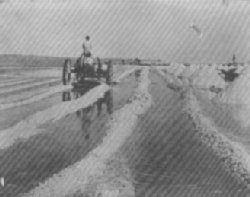|
While salt is mined in many foreign countries, much of the supply of the United States comes from the wells of Kansas and New York, from Salt Lake, in Utah, and from Michigan, Louisiana, Ohio, West Virginia, Nevada and California. Salt blocks are often erected in the vicinity of forests where there are sawmills, so that the refuse from the mills may be used as fuel.
After a derrick has been built about 80 feet high, the process of manufacturing salt in this vicinity is somewhat as follows. A well is driven by means of pipes and a sand pump, until by the pressure of air pumps brine can be forced to the surface. This brine is pumped at the rate of about 2,400 barrels in 24 hours. As the brine is brought up it is stored in great cisterns. From these cisterns the brine is drawn to settlers, where it is subjected to a heat of 170 degrees F. Then it is allowed to cool and let the impurities settle. Gypsum is the principal impurity, and if it were not drawn off it would form a coating on the machinery of the plant and would clog it. The brine now is taken into a long box over what is called a "grainer." This device consists of a long, shallow tank in the bottom of which are several steam pipes. When the brine has been admitted to this the steam is turned on, the brine is heated and evaporation rapidly takes place. To assist in this operation paddles are at work stirring the brine. As rapidly as the brine cools, the salt forms at the bottom of the grainer, and in 24 hours a layer will be found nearly eight inches deep. From this point the salt is lifted by perforated shovels to a runway, and as soon as it is drained, it is shoveled into cars and taken to the storage bins. One of the plants near Manistee has five wells, three cisterns, each 100 feet long, 8 feet deep and 18 feet wide, and six settlers capable of holding 24,000 barrels of brine. These cisterns and settlers when filled hold enough brine to make 10,000 barrels of salt.
Another process for salt making is called the "vacuum-pan" method and consists in heating the brine in a large air-tight cylinder, where it is boiled by steam. The air pressure is removed to some extent in this boiler and at 150 degrees F. the evaporation is very rapid. The grains of salt fall to the bottom of the cylinder, or "pan," and by means of an endless-bucket belt the salt is taken automatically to bins for draining. After it has drained about 18 hours, it is stored away. Some plants have two pans working, one for day and one for night, for it is necessary to clean the pans every 12 hours. The capacity of each pan is 600 or 700 barrels of salt daily. Salt plants generally have a great supply of salt on hand. It is stored in great sheds several hundred feet long, and frequently become so hardly packed that it is difficult for the laborers to break it up. Coarse salt does not pack so tightly as the vacuum salt. The latter kind often gets as hard as a wall of marble. Then men must work at it with pickaxes, shovels and even compressed air drills. These drills are about ten inches in diameter and are mounted on trucks, so that they may be wheeled about easily. To bring down a quantity of packed salt, a row of holes is drilled about six feet into the wall, a few inches above the floor. Enough will then fall in to keep a gang of men packing for a number of days. The following paragraph is taken from the "Little Chronicle," of Chicago: In the southern part of California, in a region known as the Colorado Desert, near the Colorado River, is a deposit of salt covering 1,000 acres. It lies over 250 feet below sea level and was formed by salt springs. Over this area a crust of crystallized salt, eight inches thick, has formed so hard that it has to be turned up by a steam plow. A company has been taking out salt for fifteen years undisturbed, but last December the United States got out an injunction against it for mining on public land. The suit is still pending in the courts. When the question is settled there will be great activity in the region. Only ten acres have been touched. A great drying and milling plant has been erected at Salton, an artesian well sunk, and a big town of Japanese and Indian workers built up. White men could not work in temperatures of 140 degrees over the glittering white field. The Indians wear colored goggles and suffer intolerable thirst, which the alkaline water of the single artesian well fails to quench. HIGH-GRADE TOBACCO GROWN UNDER MAMMOTH TENTS |

